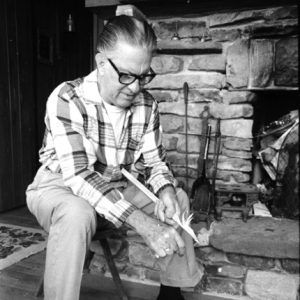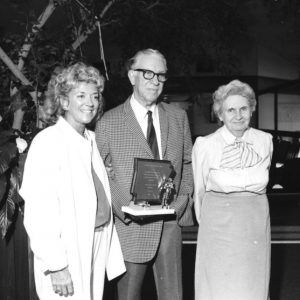calsfoundation@cals.org
Ernie Deane (1911–1991)
aka: Ernest Cecil Deane
Ernest Cecil (Ernie) Deane—journalist, teacher, historian, and folklorist—was best known for his newspaper columns, “The Arkansas Traveler” and “Ozarks Country.” He taught journalism at the University of Arkansas (UA) in Fayetteville (Washington Couny) and was a proponent to restore Old Main to its historical character at the UA campus.
Ernie Deane was born on October 29, 1911, in Lewisville (Lafayette County) to Ernest Deane, a railroad engineer, and Mabel Drew Deane. He attended public schools in Lewisville and Texarkana (Miller County). He received a bachelor’s in journalism in 1934 from UA, having served as editor of the Arkansas Traveler, the UA newspaper, and studied under the founder of the journalism department, Walter Lemke, whom Deane considered his mentor. Deane earned a master’s degree in journalism from Northwestern University at Evanston, Illinois, in 1935.
Deane married Lois Kemmerer of Magnolia (Columbia County) on June 17, 1936. They had one daughter, Frances, born in 1943, and two granddaughters, Amber and Breanna Alexander.
In January 1942, Deane enlisted in the U.S. Army and worked as a press officer for Lieutenant General Omar Bradley and General Dwight Eisenhower. However, Deane was proudest of his fifteen months as press officer for General George S. Patton. He joined the Third Army’s public relations section on June 21, 1944, in England and served throughout Patton’s command of the Third Army, until October1945. Deane traveled with Patton’s Third Army through the campaigns of Normandy, northern France, the Ardennes, the Rhineland, and central Germany. His chief duties were writing and editing the “Daily Report” between Patton and Army headquarters; too, he was staff editor for “The After Action Report.” Deane was awarded the Bronze Star and the French Croix de Guerre. He was a lieutenant colonel when he was discharged in October 1946.
As a civilian, Deane returned to Germany as an Army press officer for the Nuremberg International Military Tribunal, serving as a liaison between the military and the international press corps. From 1949 to 1955, Deane was editor and part owner of the Mexia (Texas) Daily News. In 1956, he joined the Arkansas Gazette as editorial page editor and began writing his feature column, “The Arkansas Traveler.”
After leaving the Arkansas Gazette and moving to Fayetteville, he began his “Ozarks Country” column in 1970 for The Morning News (formerly The Springdale News), which was published in seventeen newspapers until shortly before he died.
In the late 1960s, Deane worked in UA’s Office of Information Services and began teaching journalism. He taught as an associate professor of journalism from 1968 to 1976. Deane often said to his students, “I was trained in the old journalistic school of striving for accuracy, clarity, honesty, courage, fairness, completeness, and timeliness.”
Deane’s best known books are Arkansas Place Names: From Apt to Zinc by Way of Oil Trough, Toad Suck, Smackover and Ink (1986) and Ozarks Country: A Collection of Articles About Folklore, Places, People, Customs, History, and Other Ozarks Subjects (1975). His “The Arkansas Traveler” columns were compiled with other reporters’ columns in The Best of the Arkansas Traveler, 1956–1986: As Seen in the Arkansas Gazette (1986).
In 1990, Deane received the Arkansas Press Association’s Outstanding Journalism Teacher Award.
Deane was passionate about preserving local history. Deane fought to restore the original character of Old Main, the oldest building at UA, in the 1980s. Deane served on the Arkansas History Commission (now called the Arkansas State Archives) from 1974 to 1990. He was a member of the Southwest Citizens Advisory Board for the National Park Service and the War Eagle Fair Board for many years. He also taught woodcarving in War Eagle classes.
Deane died on May 7, 1991, in Fayetteville and is buried in Lewisville at Wilson Cemetery.
The Ernie Deane Award is presented annually for the journalist or writer whose work “best exemplifies the spirit, style, and courage of Ernie Deane.” Five voting members of the committee represent daily and weekly newspapers, journalism education, broadcast journalism, and public relations. The Ernie Deane Memorial Scholarship, established after Deane’s death, is awarded each year at J-Day to a UA journalism student.
For additional information:
Deane, E. C. “An Arkansas Officer in the Headquarters of General G. S. Patton Jr.” Arkansas Historical Quarterly 6 (Fall 1947): 344–350.
“Ernie Deane, Arkansas Traveler column originator, dies.” Arkansas Gazette. May 8, 1991, 1B.
Julanne S. Allison
University of Arkansas, Fayetteville
 Ernie Deane
Ernie Deane  Ernie Deane
Ernie Deane 



Ernie Deane was a true pioneer and a visionary. Since the turn of the century, taking pictures of signs and bridges and roads has become a popular hobby, but he was doing it 60 years before it became cool. He was light years ahead of his time, and I am personally grateful for all those great photographs he left us. His legacy will live forever.
Ernie Deane’s tribute to his railroad engineer father is on pages 1, 10-11 of the Arkansas Railroader April 1987 edition. See: http://thundertrain.org/APRIL-1987.pdf
The Arkansas Railroader was a publication of the Arkansas Railroad Club. There is more Deane family history in the article written by Ernie Deane about his father. Ernie Deane was a member of the Arkansas Railroad Club. Ernest Deane was a Cotton Belt engineer who retired in Lewisville in 1937.
“In November, 1965, the Cherokee Village Development Company employed Ernie Deane as the director of information at Bella Vista.”
“Deane provided excellent leadership for the Company’s public relations efforts,” then “resigned to join the journalism staff at the University of Arkansas.” (From Vision to Reality, A History Of Bella Vista Village, 1915-1993, Gilbert C. Fite, pp. 89-90)
A road was named after Deane (Deane Circle) to acknowledge his contributions to the community, as had been done previously with other company executives.